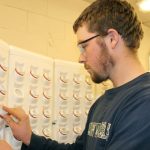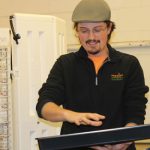Waupaca High School installs system
By Angie Landsverk
Agriculture students at Waupaca High School are learning how to grow food indoors without soil or sunlight
Earlier this month, a hydroponic system was installed there through a partnership between Feeding America Eastern Wisconsin and Fork Farms.
“It’s been a big community project,” said Alex Tyink.
He is a co-founder of the Menasha-based Fork Farms, which manufactures the plastic hydroponic system, and is also the director of programs at Feeding America Eastern Wisconsin.
Tyink represented Feeding America during his visit to WHS to help the students install the system.
He calls the product the “flex farm.”
“It’s able to be customized for what people want to use it for,” Tyink said. “We put them at food pantries through Feeding America.”
At WHS, it involved students from three classes – Aquaculture, Outdoor Recreation and Ecology and Wildlife Management.
They put the plant snaps in place in the system.
“You will plant into the snaps and harvest them by pulling them out,” Tyink told the students.
That day, students planted clay coated seeds and put them under lights.
“From seed to putting them in the system is 10 to 14 days,” Tyink said. “Then, after it’s in the system, it’s another 25 to 35 days before it’s ready to harvest.”
He also told the students they should see a 95 percent germination rate and growth within 24 to 48 hours of planting the seeds.
“Once you see green, plants up, you can start giving them nutrients,” he said.
Tyink said hydropinics is a way to grow food in a more sustainable way.
The Appleton native made 28 different prototypes for this system.
He started doing so when he was living in New York City.
Tyink went to school to be an opera singer and lived in New York City about four years before moving back to Wisconsin in 2012.
While living in New York City, he met someone who was growing food on a rooftop for a nonprofit.
Tyink started volunteering with the organization and got contracted to help build systems.
“I did the math one day,” he said. “If (the system) had low energy efficiency. It was costing about $6 per pound to grow the plants. That’s unacceptable. You can go to a grocery store and get it cheaper. I started thinking about how we could get the cost down and make it more energy efficient.”
He worked on prototypes in his apartment.
With the cost of living high there, Tyink thought, “I can do this anywhere. I thought why not go home and do it.”
After returning to Wisconsin, he ran Goodwill’s garden program for three years.
Two years ago, Feeding America hired him.
Fork Farms started last May.
“This is about the 24th installation we’ve done in the first six months,” Tyink said. “People like it. It’s not a perfect system. We will keep developing the technology. It’s affordable enough that it makes sense for schools to do it.”
The approximate cost of the system installed at WHS was $3,400.
Rene Lehman, an agriculture instructor at WHS, said a $1,000 grant from the Waupaca Breakfast Rotary Club went toward the cost.
The remainder of the cost will be covered by the Carl Perkins funds the school receives and profits from the school’s greenhouse sales.
“We sell, so why not invest in something that will be another venue for the students to give back to the community,” she said.
Lehman said the Carl Perkins funds are to be used specifically in the technical education areas.
She found out about Fork Farms’ system through an email from Feeding America.
Feeding America was interested in pairing up with Waupaca’s food pantry, she said.
Lehman suggested installing a system at the high school, where students could take care of it.
“Last July, I went to Fork Farms to see the setup and operation of it,” she said. “Our hope is to actually be able to supply some food in the cafeteria here at school.”
Other possible uses would be for the local food pantry and the school’s family and consumer science classes, Lehman said.
Tyink said the system was designed to grow leafy greens, but schools are growing other items as well.
“We have had schools do peppers, tomatoes, strawberries,” he said. “We have had schools do pumpkins.”
About a dozen installations are already lined up for 2018, and Tyink said businesses and individuals may buy the system as well.
Lehman said the biggest lessons for her students will be testing the water and making sure the plants receive the proper nutrient levels.
“Evenually, I’d like to connect our fish farm and use it in the system,” she said. “Alex said he would work with me to try to connect it. Instead of hydroponics, it would be aquaponics.”
Lehman said the hydroponic growing system will also open up opportunities for students to see what it produces and compare that to the same area in the ground.
“I’m excited,” she said. “The students were just awesome in here putting it together.”



